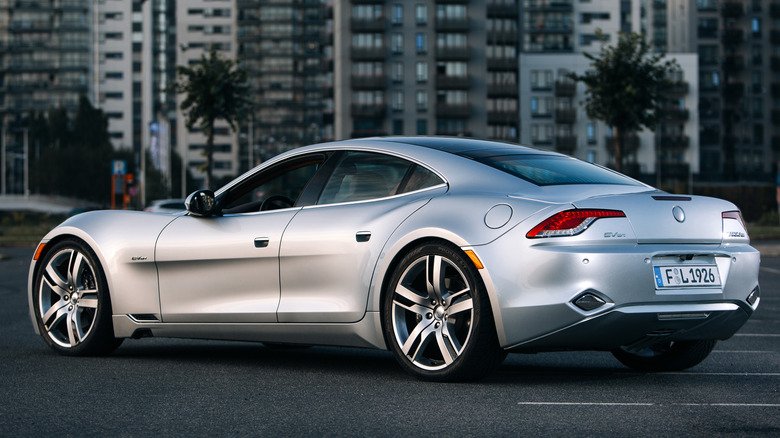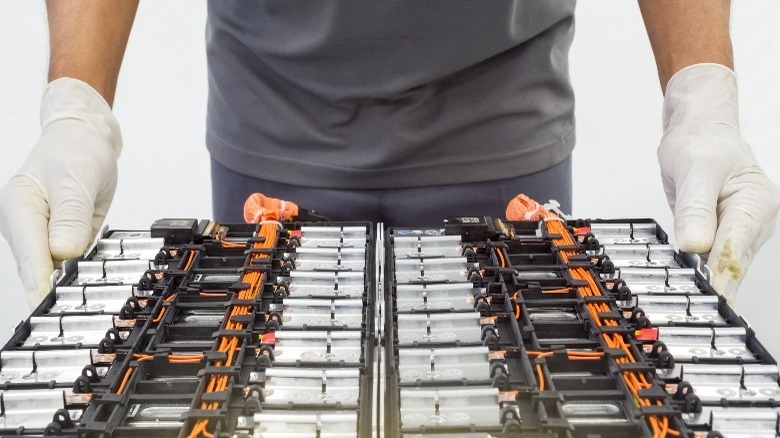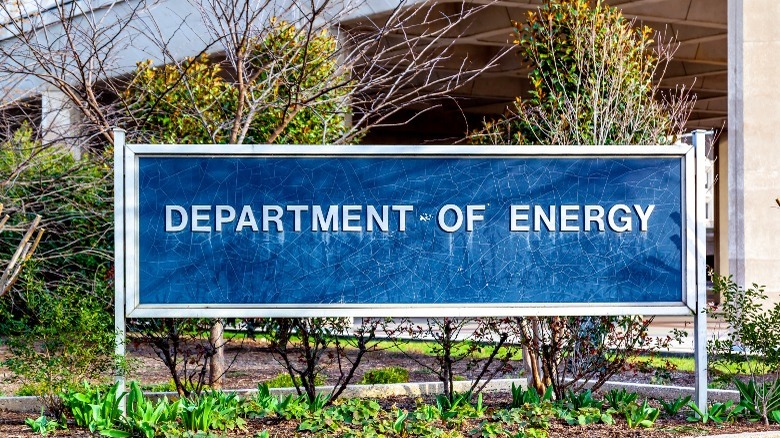The Reason The Fisker Karma Was A Failure
The Fisker Ocean electric SUV is set to launch in 2023, and Fisker Incorporated is hoping that it'll give the Tesla Model Y a run for its money. Before the Ocean project, however, Fisker CEO Henrik Fisker was involved with an equally-exciting sustainable automotive project that turned out disastrously. The 2011 Fisker Karma was a luxury four-door electric sports sedan that promised to dethrone the first-generation Tesla Roadster, which captured the hearts of motoring enthusiasts when it launched in 2008.
Despite Fisker being a seasoned automotive designer — having worked on the BMW Z8, Aston Martin DB9, Aston Martin V8 Vantage, and the Tesla Model S, according to Motor Trend — he made some errors in both design and production that ultimately led to the failure of both the Karma and Fisker Automotive as a whole. While the actual production version of the Karma was praised by reviewers for its beauty, many were disappointed by its meager acceleration speed of 0 to 60 miles per hour in just over 6 seconds, especially considering its sporty styling and the reputation electric cars had for being quick off the block.
Even more damning was the Karma unit obtained by Consumer Reports, which promptly died shortly after it was purchased; the organization further reported that other Fisker Karma owners had also experienced many issues mostly relating to the software. Needless to say, this certainly earned the $100,000 vehicle a poor reputation for reliability, something enshrined in a series of bad reviews from consumers (via Cars.com). The Karma model was doomed long before battery and reliability issues, though.
Fisker's battery problems weren't the worst of its issues
It's difficult to point to a single flaw as the reason for the Fisker Karma's failure. It's more a story of multiple financial, engineering, and production failures that led to the company declaring bankruptcy and selling all of its assets to Wanxiang Group before re-branding as Karma Automotive. As a hybrid vehicle, the Fisker Karma needed an internal combustion engine, battery pack, and electric motors, and as a relatively new company, Fisker Automotive decided to partner with specialists to design and production of most of the internals of the vehicle.
According to Green Car Reports, the internal combustion engine in the Karma was a GM Ecotec engine, while the battery was provided by A123 Systems — a smaller company that had some promising new technology but didn't have the reputation of its larger contemporaries, like LG Chem and Panasonic. That lack of long-term testing came to a head in 2013. To put a finer point on it, the National Highway Traffic Safety Administration had issued a number of recalls for the Karma relating to manufacturing defects in the battery packs that could result in fire risk, as well as a variety of airbag safety issues. To make matters worse, A123 Systems — Fisker's only source for batteries — would go bankrupt in 2012, according to Reuters, forcing Fisker to cease production of the Karma.
Even federal funds can only go so far
While battery recalls and supply issues are certainly problematic for a plug-in hybrid manufacturer, Fisker's financial situation was even more troubling. The U.S. Department of Energy helped provide funding for a number of green vehicle projects in an effort to accelerate the switch to sustainable energy. Fisker was set to receive a $528 million loan from the federal government to buy an old GM manufacturing facility in Delaware and pay its staff during the startup phase, but it only ended up drawing $169 million of that funding before it was withdrawn.
According to The New York Times, the rest of the funding was pulled when Fisker failed to meet production deadlines and missed loan repayments. This sudden reduction in cash flow made it difficult for Fisker to pay the bills, so to speak. With only 2,450 Karmas delivered to consumers before production stopped, each Karma cost Fisker $660,000 to produce, according to Autoblog.
In March 2013, Henrik Fisker would leave Fisker Automotive, citing disagreements with executive management as the reason for his departure. According to Autoweek, Fisker Automotive laid off 160 employees just one month after Fisker himself left the company, axing around 75% of its total staff. This last round of layoffs left mostly management in place to deal with the bankruptcy proceedings and the eventual sale of the company to Wanxiang Group, which would later turn the company into Karma Automotive and release the Karma Revero as a successor to the original Fisker Karma.


